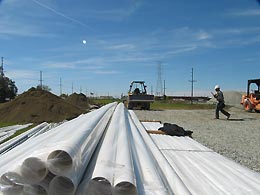Contact Superfund, Pacific Southwest
Pacific Southwest, Region 9
Serving: Arizona, California, Hawaii, Nevada, Pacific Islands, Tribal Nations
EPA Begins Construction of Soil Treatment System at Del Amo Superfund Site

Recently EPA and Shell Oil Company started constructing a new soil vapor extraction system at the Del Amo Superfund site in Harbor Gateway, Calif., which will remove volatile organic contaminants from the soil at the former industrial site.
The EPA’s new soil vapor extraction and bioventing system will use a blower to extract soil vapor from existing soil vapor extracting wells. Approximately 25% of the extracted vapors will be treated with carbon filters and released to the air; the remaining vapors will be oxygenated and be re-injected into the contaminated soil to accelerate bacterial break -down of contaminants. This process of extraction and re-injection will continue until clean-up goals are met.
"This innovative soil vapor extraction and treatment system will help us effectively address the threat to groundwater from the Del Amo Superfund site waste pits in the most environmentally friendly manner," said Keith Takata, EPA's Superfund director. "We made this decision only after an extensive, open and honest dialogue with the community and other stakeholders."
Located at the corner of Vermont Ave. and Del Amo Blvd., the Del Amo Superfund site waste pits area was used as an industrial dump site between 1943 and 1972. Wastes - including benzene, naphthalene, ethylbenzene and phenol - contaminated the surrounding soil and groundwater.
In 1997, the EPA began cleaning-up the Del Amo Superfund site, starting with a multi-layer impermeable cap over the waste pits and installation of the soil-vapor extraction wells. In September, 2002, the Del Amo facility was placed on the EPA’s National Priorities’ List of the most contaminated sites in the US.
